Commemorative Event Held Aboard RSV 421 Next to Fragments of Crashed Argentine Aircraft Found by Bulgarian Researchers in Antarctica

Commemorative Event Held Aboard RSV 421 Next to Fragments of Crashed Argentine Aircraft Found by Bulgarian Researchers in Antarctica
LIVINGSTON ISLAND, 05.02.2024
A commemorative ceremony was held aboard the Bulgarian naval research and survey vessel Sv. Sv. Kiril i Metodii (RSV 421) on Sunday for Argentine researchers who lost their lives in Antarctica in 1976. The researchers died in a plane crash, fragments of which were found by Bulgarian researchers at the end of January during the collection of geological samples in the area of Livingston Island's False Bay and Barnard Point. Sunday's commemorative event took place in the same area, the Nikola Vaptsarov Naval Academy reported Monday.
It was initially believed the fragments were part of a C-130 Hercules transport airplane that the Chilean Air Force lost in the area of the Drake Passage in 2019. However, Bulgarian geologists Kalin Naydenov and Kiril Doskov and climbers Doychin Boyanov and Marcho Paunov later found a part of the sun on Argentina's flag, confirming that the fragments belong to a Neptune 2-P-103 of the Argentine Naval Research Squadron.
Early on September 15, 1976, the aircraft took off from the Rio Grande Naval Base with a ten-member crew to research the state of the ice in the Drake Passage and near the South Shetland Islands. The communication with the aircraft was lost, and a crash site was later established on one of the slopes of Bernard Mountain on Livingston Island. No survivors were found. In January 1977, during a search for the crew's bodies, a BELL 212 helicopter crashed; all three crew members died.
Attending Sunday's commemorative ceremony were scientists on the expedition from the Spanish Geographical Association and Argentine polar researchers. The ceremony was unveiled by the head of the Nikola Vaptsarov Naval Academy, Flotilla Admiral Boyan Mednikarov.
BTA Photo
news.anonymous.signup
news.anonymous.login
A commemorative ceremony was held aboard the Bulgarian naval research and survey vessel Sv. Sv. Kiril i Metodii (RSV 421) on Sunday for Argentine researchers who lost their lives in Antarctica in 1976. The researchers died in a plane crash, fragments of which were found by Bulgarian researchers at the end of January during the collection of geological samples in the area of Livingston Island's False Bay and Barnard Point. Sunday's commemorative event took place in the same area, the Nikola Vaptsarov Naval Academy reported Monday.
It was initially believed the fragments were part of a C-130 Hercules transport airplane that the Chilean Air Force lost in the area of the Drake Passage in 2019. However, Bulgarian geologists Kalin Naydenov and Kiril Doskov and climbers Doychin Boyanov and Marcho Paunov later found a part of the sun on Argentina's flag, confirming that the fragments belong to a Neptune 2-P-103 of the Argentine Naval Research Squadron.
Early on September 15, 1976, the aircraft took off from the Rio Grande Naval Base with a ten-member crew to research the state of the ice in the Drake Passage and near the South Shetland Islands. The communication with the aircraft was lost, and a crash site was later established on one of the slopes of Bernard Mountain on Livingston Island. No survivors were found. In January 1977, during a search for the crew's bodies, a BELL 212 helicopter crashed; all three crew members died.
Attending Sunday's commemorative ceremony were scientists on the expedition from the Spanish Geographical Association and Argentine polar researchers. The ceremony was unveiled by the head of the Nikola Vaptsarov Naval Academy, Flotilla Admiral Boyan Mednikarov.
BTA Photo
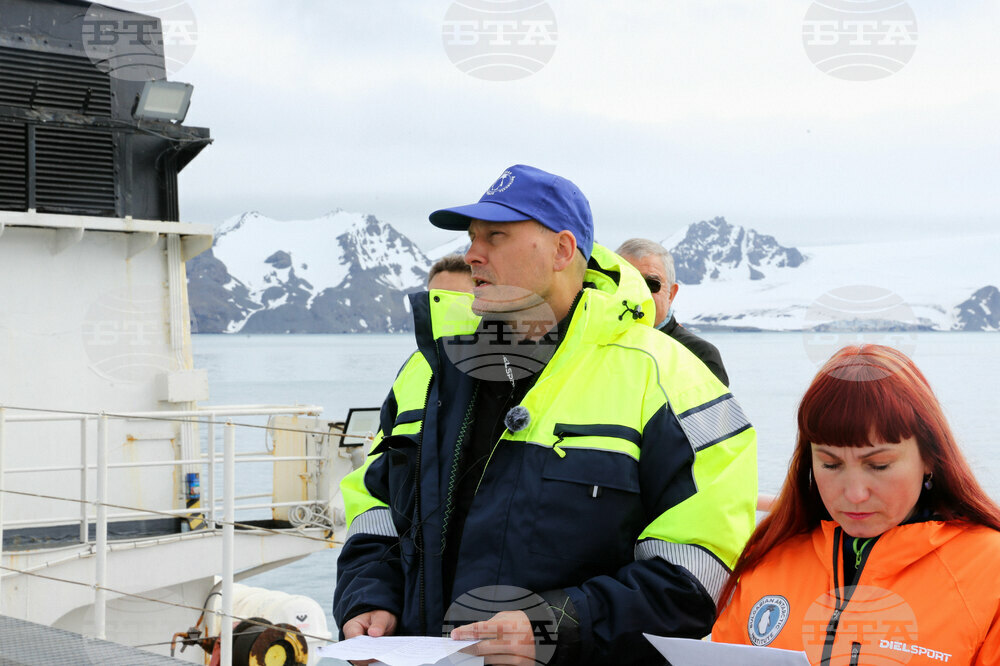
Commemorative Event Held Aboard RSV 421 Next to Fragments of Crashed Argentine Aircraft Found by Bulgarian Researchers in Antarctica
LIVINGSTON ISLAND, 05.02.2024
A commemorative ceremony was held aboard the Bulgarian naval research and survey vessel Sv. Sv. Kiril i Metodii (RSV 421) on Sunday for Argentine researchers who lost their lives in Antarctica in 1976. The researchers died in a plane crash, fragments of which were found by Bulgarian researchers at the end of January during the collection of geological samples in the area of Livingston Island's False Bay and Barnard Point. Sunday's commemorative event took place in the same area, the Nikola Vaptsarov Naval Academy reported Monday.
It was initially believed the fragments were part of a C-130 Hercules transport airplane that the Chilean Air Force lost in the area of the Drake Passage in 2019. However, Bulgarian geologists Kalin Naydenov and Kiril Doskov and climbers Doychin Boyanov and Marcho Paunov later found a part of the sun on Argentina's flag, confirming that the fragments belong to a Neptune 2-P-103 of the Argentine Naval Research Squadron.
Early on September 15, 1976, the aircraft took off from the Rio Grande Naval Base with a ten-member crew to research the state of the ice in the Drake Passage and near the South Shetland Islands. The communication with the aircraft was lost, and a crash site was later established on one of the slopes of Bernard Mountain on Livingston Island. No survivors were found. In January 1977, during a search for the crew's bodies, a BELL 212 helicopter crashed; all three crew members died.
Attending Sunday's commemorative ceremony were scientists on the expedition from the Spanish Geographical Association and Argentine polar researchers. The ceremony was unveiled by the head of the Nikola Vaptsarov Naval Academy, Flotilla Admiral Boyan Mednikarov.
BTA Photo
news.anonymous.signup
news.anonymous.login
A commemorative ceremony was held aboard the Bulgarian naval research and survey vessel Sv. Sv. Kiril i Metodii (RSV 421) on Sunday for Argentine researchers who lost their lives in Antarctica in 1976. The researchers died in a plane crash, fragments of which were found by Bulgarian researchers at the end of January during the collection of geological samples in the area of Livingston Island's False Bay and Barnard Point. Sunday's commemorative event took place in the same area, the Nikola Vaptsarov Naval Academy reported Monday.
It was initially believed the fragments were part of a C-130 Hercules transport airplane that the Chilean Air Force lost in the area of the Drake Passage in 2019. However, Bulgarian geologists Kalin Naydenov and Kiril Doskov and climbers Doychin Boyanov and Marcho Paunov later found a part of the sun on Argentina's flag, confirming that the fragments belong to a Neptune 2-P-103 of the Argentine Naval Research Squadron.
Early on September 15, 1976, the aircraft took off from the Rio Grande Naval Base with a ten-member crew to research the state of the ice in the Drake Passage and near the South Shetland Islands. The communication with the aircraft was lost, and a crash site was later established on one of the slopes of Bernard Mountain on Livingston Island. No survivors were found. In January 1977, during a search for the crew's bodies, a BELL 212 helicopter crashed; all three crew members died.
Attending Sunday's commemorative ceremony were scientists on the expedition from the Spanish Geographical Association and Argentine polar researchers. The ceremony was unveiled by the head of the Nikola Vaptsarov Naval Academy, Flotilla Admiral Boyan Mednikarov.
BTA Photo
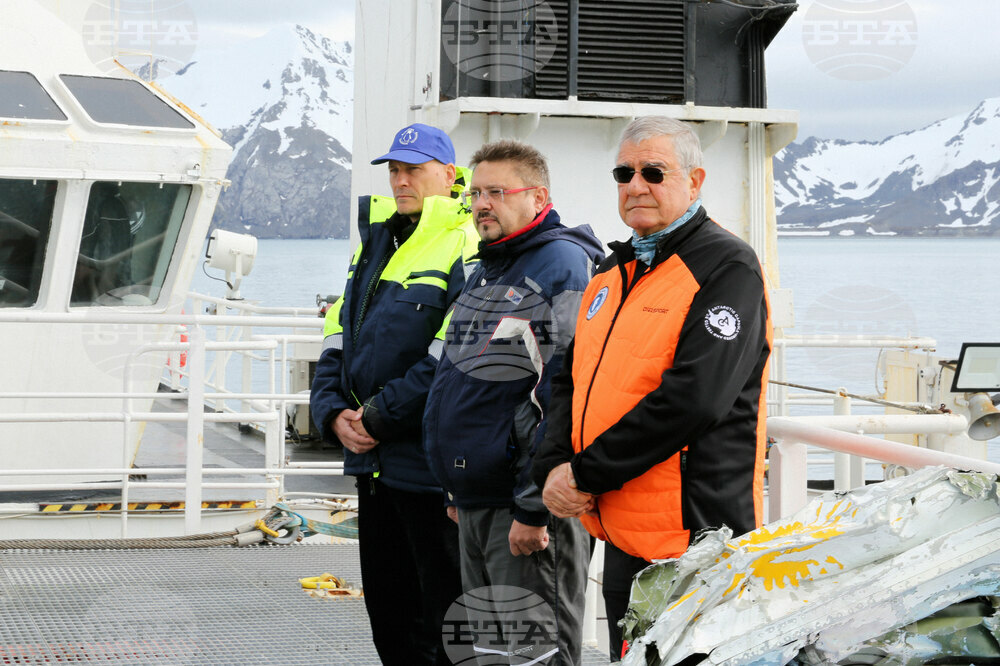
Commemorative Event Held Aboard RSV 421 Next to Fragments of Crashed Argentine Aircraft Found by Bulgarian Researchers in Antarctica
LIVINGSTON ISLAND, 05.02.2024
A commemorative ceremony was held aboard the Bulgarian naval research and survey vessel Sv. Sv. Kiril i Metodii (RSV 421) on Sunday for Argentine researchers who lost their lives in Antarctica in 1976. The researchers died in a plane crash, fragments of which were found by Bulgarian researchers at the end of January during the collection of geological samples in the area of Livingston Island's False Bay and Barnard Point. Sunday's commemorative event took place in the same area, the Nikola Vaptsarov Naval Academy reported Monday.
It was initially believed the fragments were part of a C-130 Hercules transport airplane that the Chilean Air Force lost in the area of the Drake Passage in 2019. However, Bulgarian geologists Kalin Naydenov and Kiril Doskov and climbers Doychin Boyanov and Marcho Paunov later found a part of the sun on Argentina's flag, confirming that the fragments belong to a Neptune 2-P-103 of the Argentine Naval Research Squadron.
Early on September 15, 1976, the aircraft took off from the Rio Grande Naval Base with a ten-member crew to research the state of the ice in the Drake Passage and near the South Shetland Islands. The communication with the aircraft was lost, and a crash site was later established on one of the slopes of Bernard Mountain on Livingston Island. No survivors were found. In January 1977, during a search for the crew's bodies, a BELL 212 helicopter crashed; all three crew members died.
Attending Sunday's commemorative ceremony were scientists on the expedition from the Spanish Geographical Association and Argentine polar researchers. The ceremony was unveiled by the head of the Nikola Vaptsarov Naval Academy, Flotilla Admiral Boyan Mednikarov.
BTA Photo
news.anonymous.signup
news.anonymous.login
A commemorative ceremony was held aboard the Bulgarian naval research and survey vessel Sv. Sv. Kiril i Metodii (RSV 421) on Sunday for Argentine researchers who lost their lives in Antarctica in 1976. The researchers died in a plane crash, fragments of which were found by Bulgarian researchers at the end of January during the collection of geological samples in the area of Livingston Island's False Bay and Barnard Point. Sunday's commemorative event took place in the same area, the Nikola Vaptsarov Naval Academy reported Monday.
It was initially believed the fragments were part of a C-130 Hercules transport airplane that the Chilean Air Force lost in the area of the Drake Passage in 2019. However, Bulgarian geologists Kalin Naydenov and Kiril Doskov and climbers Doychin Boyanov and Marcho Paunov later found a part of the sun on Argentina's flag, confirming that the fragments belong to a Neptune 2-P-103 of the Argentine Naval Research Squadron.
Early on September 15, 1976, the aircraft took off from the Rio Grande Naval Base with a ten-member crew to research the state of the ice in the Drake Passage and near the South Shetland Islands. The communication with the aircraft was lost, and a crash site was later established on one of the slopes of Bernard Mountain on Livingston Island. No survivors were found. In January 1977, during a search for the crew's bodies, a BELL 212 helicopter crashed; all three crew members died.
Attending Sunday's commemorative ceremony were scientists on the expedition from the Spanish Geographical Association and Argentine polar researchers. The ceremony was unveiled by the head of the Nikola Vaptsarov Naval Academy, Flotilla Admiral Boyan Mednikarov.
BTA Photo
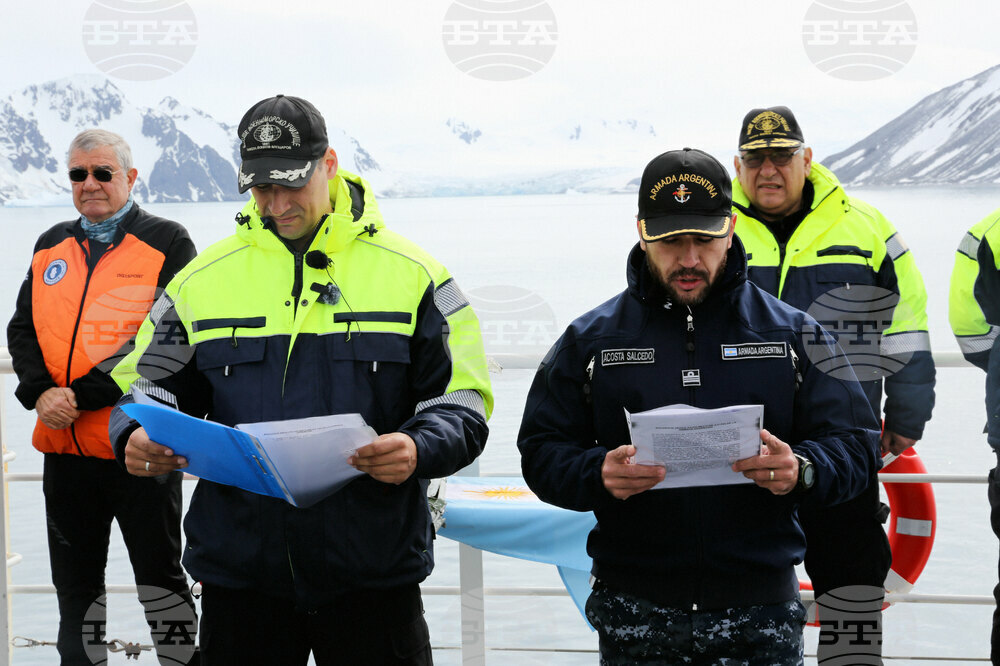
Commemorative Event Held Aboard RSV 421 Next to Fragments of Crashed Argentine Aircraft Found by Bulgarian Researchers in Antarctica
LIVINGSTON ISLAND, 05.02.2024
A commemorative ceremony was held aboard the Bulgarian naval research and survey vessel Sv. Sv. Kiril i Metodii (RSV 421) on Sunday for Argentine researchers who lost their lives in Antarctica in 1976. The researchers died in a plane crash, fragments of which were found by Bulgarian researchers at the end of January during the collection of geological samples in the area of Livingston Island's False Bay and Barnard Point. Sunday's commemorative event took place in the same area, the Nikola Vaptsarov Naval Academy reported Monday.
It was initially believed the fragments were part of a C-130 Hercules transport airplane that the Chilean Air Force lost in the area of the Drake Passage in 2019. However, Bulgarian geologists Kalin Naydenov and Kiril Doskov and climbers Doychin Boyanov and Marcho Paunov later found a part of the sun on Argentina's flag, confirming that the fragments belong to a Neptune 2-P-103 of the Argentine Naval Research Squadron.
Early on September 15, 1976, the aircraft took off from the Rio Grande Naval Base with a ten-member crew to research the state of the ice in the Drake Passage and near the South Shetland Islands. The communication with the aircraft was lost, and a crash site was later established on one of the slopes of Bernard Mountain on Livingston Island. No survivors were found. In January 1977, during a search for the crew's bodies, a BELL 212 helicopter crashed; all three crew members died.
Attending Sunday's commemorative ceremony were scientists on the expedition from the Spanish Geographical Association and Argentine polar researchers. The ceremony was unveiled by the head of the Nikola Vaptsarov Naval Academy, Flotilla Admiral Boyan Mednikarov.
BTA Photo
news.anonymous.signup
news.anonymous.login
A commemorative ceremony was held aboard the Bulgarian naval research and survey vessel Sv. Sv. Kiril i Metodii (RSV 421) on Sunday for Argentine researchers who lost their lives in Antarctica in 1976. The researchers died in a plane crash, fragments of which were found by Bulgarian researchers at the end of January during the collection of geological samples in the area of Livingston Island's False Bay and Barnard Point. Sunday's commemorative event took place in the same area, the Nikola Vaptsarov Naval Academy reported Monday.
It was initially believed the fragments were part of a C-130 Hercules transport airplane that the Chilean Air Force lost in the area of the Drake Passage in 2019. However, Bulgarian geologists Kalin Naydenov and Kiril Doskov and climbers Doychin Boyanov and Marcho Paunov later found a part of the sun on Argentina's flag, confirming that the fragments belong to a Neptune 2-P-103 of the Argentine Naval Research Squadron.
Early on September 15, 1976, the aircraft took off from the Rio Grande Naval Base with a ten-member crew to research the state of the ice in the Drake Passage and near the South Shetland Islands. The communication with the aircraft was lost, and a crash site was later established on one of the slopes of Bernard Mountain on Livingston Island. No survivors were found. In January 1977, during a search for the crew's bodies, a BELL 212 helicopter crashed; all three crew members died.
Attending Sunday's commemorative ceremony were scientists on the expedition from the Spanish Geographical Association and Argentine polar researchers. The ceremony was unveiled by the head of the Nikola Vaptsarov Naval Academy, Flotilla Admiral Boyan Mednikarov.
BTA Photo
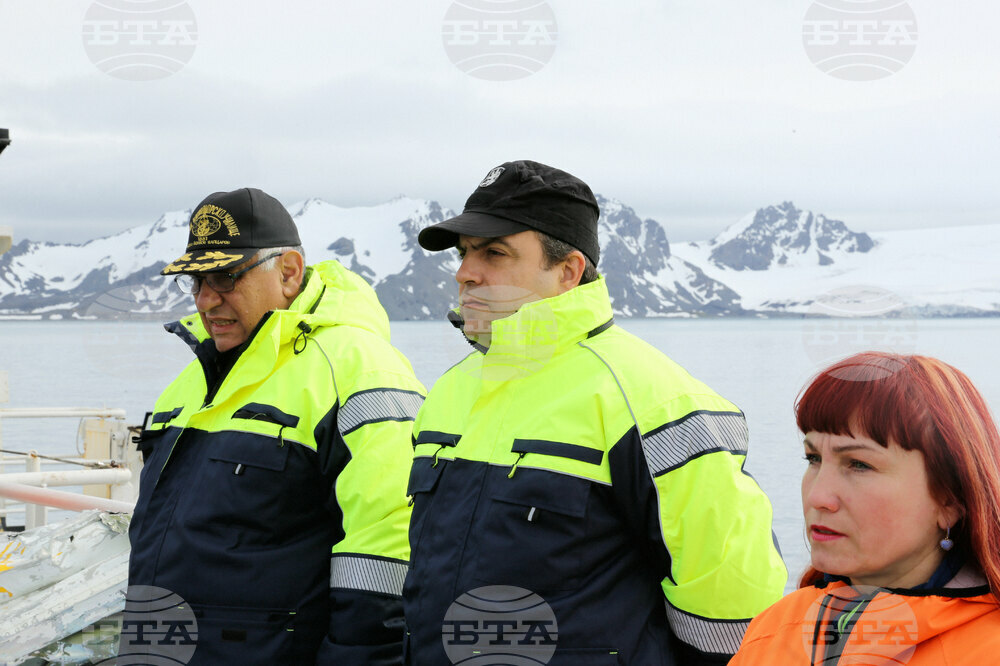
Commemorative Event Held Aboard RSV 421 Next to Fragments of Crashed Argentine Aircraft Found by Bulgarian Researchers in Antarctica
LIVINGSTON ISLAND, 05.02.2024
A commemorative ceremony was held aboard the Bulgarian naval research and survey vessel Sv. Sv. Kiril i Metodii (RSV 421) on Sunday for Argentine researchers who lost their lives in Antarctica in 1976. The researchers died in a plane crash, fragments of which were found by Bulgarian researchers at the end of January during the collection of geological samples in the area of Livingston Island's False Bay and Barnard Point. Sunday's commemorative event took place in the same area, the Nikola Vaptsarov Naval Academy reported Monday.
It was initially believed the fragments were part of a C-130 Hercules transport airplane that the Chilean Air Force lost in the area of the Drake Passage in 2019. However, Bulgarian geologists Kalin Naydenov and Kiril Doskov and climbers Doychin Boyanov and Marcho Paunov later found a part of the sun on Argentina's flag, confirming that the fragments belong to a Neptune 2-P-103 of the Argentine Naval Research Squadron.
Early on September 15, 1976, the aircraft took off from the Rio Grande Naval Base with a ten-member crew to research the state of the ice in the Drake Passage and near the South Shetland Islands. The communication with the aircraft was lost, and a crash site was later established on one of the slopes of Bernard Mountain on Livingston Island. No survivors were found. In January 1977, during a search for the crew's bodies, a BELL 212 helicopter crashed; all three crew members died.
Attending Sunday's commemorative ceremony were scientists on the expedition from the Spanish Geographical Association and Argentine polar researchers. The ceremony was unveiled by the head of the Nikola Vaptsarov Naval Academy, Flotilla Admiral Boyan Mednikarov.
BTA Photo
news.anonymous.signup
news.anonymous.login
A commemorative ceremony was held aboard the Bulgarian naval research and survey vessel Sv. Sv. Kiril i Metodii (RSV 421) on Sunday for Argentine researchers who lost their lives in Antarctica in 1976. The researchers died in a plane crash, fragments of which were found by Bulgarian researchers at the end of January during the collection of geological samples in the area of Livingston Island's False Bay and Barnard Point. Sunday's commemorative event took place in the same area, the Nikola Vaptsarov Naval Academy reported Monday.
It was initially believed the fragments were part of a C-130 Hercules transport airplane that the Chilean Air Force lost in the area of the Drake Passage in 2019. However, Bulgarian geologists Kalin Naydenov and Kiril Doskov and climbers Doychin Boyanov and Marcho Paunov later found a part of the sun on Argentina's flag, confirming that the fragments belong to a Neptune 2-P-103 of the Argentine Naval Research Squadron.
Early on September 15, 1976, the aircraft took off from the Rio Grande Naval Base with a ten-member crew to research the state of the ice in the Drake Passage and near the South Shetland Islands. The communication with the aircraft was lost, and a crash site was later established on one of the slopes of Bernard Mountain on Livingston Island. No survivors were found. In January 1977, during a search for the crew's bodies, a BELL 212 helicopter crashed; all three crew members died.
Attending Sunday's commemorative ceremony were scientists on the expedition from the Spanish Geographical Association and Argentine polar researchers. The ceremony was unveiled by the head of the Nikola Vaptsarov Naval Academy, Flotilla Admiral Boyan Mednikarov.
BTA Photo
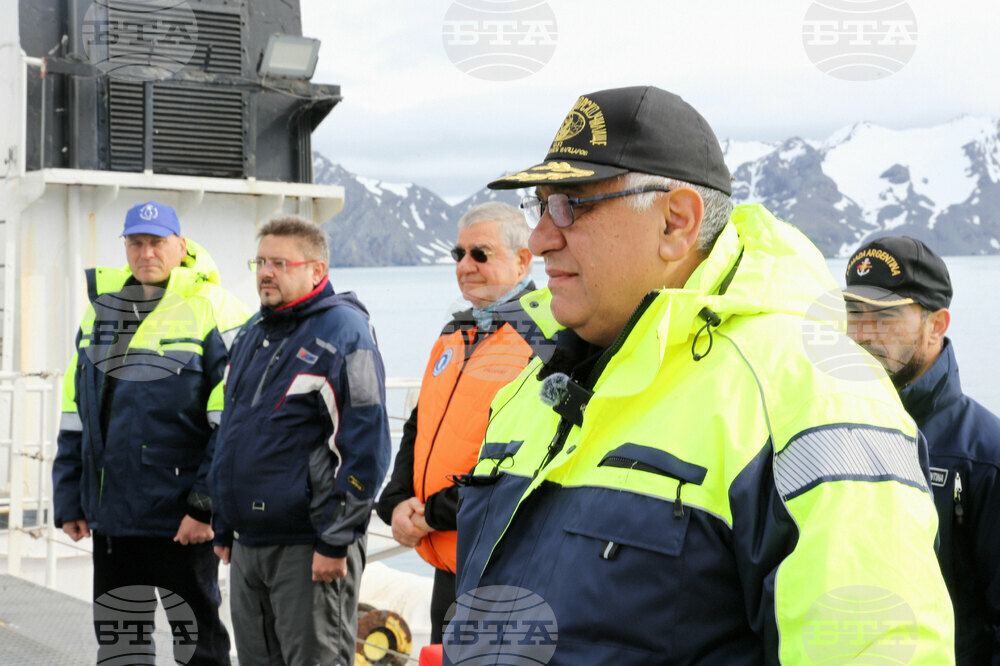
Commemorative Event Held Aboard RSV 421 Next to Fragments of Crashed Argentine Aircraft Found by Bulgarian Researchers in Antarctica
LIVINGSTON ISLAND, 05.02.2024
A commemorative ceremony was held aboard the Bulgarian naval research and survey vessel Sv. Sv. Kiril i Metodii (RSV 421) on Sunday for Argentine researchers who lost their lives in Antarctica in 1976. The researchers died in a plane crash, fragments of which were found by Bulgarian researchers at the end of January during the collection of geological samples in the area of Livingston Island's False Bay and Barnard Point. Sunday's commemorative event took place in the same area, the Nikola Vaptsarov Naval Academy reported Monday.
It was initially believed the fragments were part of a C-130 Hercules transport airplane that the Chilean Air Force lost in the area of the Drake Passage in 2019. However, Bulgarian geologists Kalin Naydenov and Kiril Doskov and climbers Doychin Boyanov and Marcho Paunov later found a part of the sun on Argentina's flag, confirming that the fragments belong to a Neptune 2-P-103 of the Argentine Naval Research Squadron.
Early on September 15, 1976, the aircraft took off from the Rio Grande Naval Base with a ten-member crew to research the state of the ice in the Drake Passage and near the South Shetland Islands. The communication with the aircraft was lost, and a crash site was later established on one of the slopes of Bernard Mountain on Livingston Island. No survivors were found. In January 1977, during a search for the crew's bodies, a BELL 212 helicopter crashed; all three crew members died.
Attending Sunday's commemorative ceremony were scientists on the expedition from the Spanish Geographical Association and Argentine polar researchers. The ceremony was unveiled by the head of the Nikola Vaptsarov Naval Academy, Flotilla Admiral Boyan Mednikarov.
BTA Photo
news.anonymous.signup
news.anonymous.login
A commemorative ceremony was held aboard the Bulgarian naval research and survey vessel Sv. Sv. Kiril i Metodii (RSV 421) on Sunday for Argentine researchers who lost their lives in Antarctica in 1976. The researchers died in a plane crash, fragments of which were found by Bulgarian researchers at the end of January during the collection of geological samples in the area of Livingston Island's False Bay and Barnard Point. Sunday's commemorative event took place in the same area, the Nikola Vaptsarov Naval Academy reported Monday.
It was initially believed the fragments were part of a C-130 Hercules transport airplane that the Chilean Air Force lost in the area of the Drake Passage in 2019. However, Bulgarian geologists Kalin Naydenov and Kiril Doskov and climbers Doychin Boyanov and Marcho Paunov later found a part of the sun on Argentina's flag, confirming that the fragments belong to a Neptune 2-P-103 of the Argentine Naval Research Squadron.
Early on September 15, 1976, the aircraft took off from the Rio Grande Naval Base with a ten-member crew to research the state of the ice in the Drake Passage and near the South Shetland Islands. The communication with the aircraft was lost, and a crash site was later established on one of the slopes of Bernard Mountain on Livingston Island. No survivors were found. In January 1977, during a search for the crew's bodies, a BELL 212 helicopter crashed; all three crew members died.
Attending Sunday's commemorative ceremony were scientists on the expedition from the Spanish Geographical Association and Argentine polar researchers. The ceremony was unveiled by the head of the Nikola Vaptsarov Naval Academy, Flotilla Admiral Boyan Mednikarov.
BTA Photo
Commemorative Event Held Aboard RSV 421 Next to Fragments of Crashed Argentine Aircraft Found by Bulgarian Researchers in Antarctica
LIVINGSTON ISLAND, 05.02.2024
A commemorative ceremony was held aboard the Bulgarian naval research and survey vessel Sv. Sv. Kiril i Metodii (RSV 421) on Sunday for Argentine researchers who lost their lives in Antarctica in 1976. The researchers died in a plane crash, fragments of which were found by Bulgarian researchers at the end of January during the collection of geological samples in the area of Livingston Island's False Bay and Barnard Point. Sunday's commemorative event took place in the same area, the Nikola Vaptsarov Naval Academy reported Monday.
It was initially believed the fragments were part of a C-130 Hercules transport airplane that the Chilean Air Force lost in the area of the Drake Passage in 2019. However, Bulgarian geologists Kalin Naydenov and Kiril Doskov and climbers Doychin Boyanov and Marcho Paunov later found a part of the sun on Argentina's flag, confirming that the fragments belong to a Neptune 2-P-103 of the Argentine Naval Research Squadron.
Early on September 15, 1976, the aircraft took off from the Rio Grande Naval Base with a ten-member crew to research the state of the ice in the Drake Passage and near the South Shetland Islands. The communication with the aircraft was lost, and a crash site was later established on one of the slopes of Bernard Mountain on Livingston Island. No survivors were found. In January 1977, during a search for the crew's bodies, a BELL 212 helicopter crashed; all three crew members died.
Attending Sunday's commemorative ceremony were scientists on the expedition from the Spanish Geographical Association and Argentine polar researchers. The ceremony was unveiled by the head of the Nikola Vaptsarov Naval Academy, Flotilla Admiral Boyan Mednikarov.
BTA Photo
news.anonymous.signup
news.anonymous.login
A commemorative ceremony was held aboard the Bulgarian naval research and survey vessel Sv. Sv. Kiril i Metodii (RSV 421) on Sunday for Argentine researchers who lost their lives in Antarctica in 1976. The researchers died in a plane crash, fragments of which were found by Bulgarian researchers at the end of January during the collection of geological samples in the area of Livingston Island's False Bay and Barnard Point. Sunday's commemorative event took place in the same area, the Nikola Vaptsarov Naval Academy reported Monday.
It was initially believed the fragments were part of a C-130 Hercules transport airplane that the Chilean Air Force lost in the area of the Drake Passage in 2019. However, Bulgarian geologists Kalin Naydenov and Kiril Doskov and climbers Doychin Boyanov and Marcho Paunov later found a part of the sun on Argentina's flag, confirming that the fragments belong to a Neptune 2-P-103 of the Argentine Naval Research Squadron.
Early on September 15, 1976, the aircraft took off from the Rio Grande Naval Base with a ten-member crew to research the state of the ice in the Drake Passage and near the South Shetland Islands. The communication with the aircraft was lost, and a crash site was later established on one of the slopes of Bernard Mountain on Livingston Island. No survivors were found. In January 1977, during a search for the crew's bodies, a BELL 212 helicopter crashed; all three crew members died.
Attending Sunday's commemorative ceremony were scientists on the expedition from the Spanish Geographical Association and Argentine polar researchers. The ceremony was unveiled by the head of the Nikola Vaptsarov Naval Academy, Flotilla Admiral Boyan Mednikarov.
BTA Photo
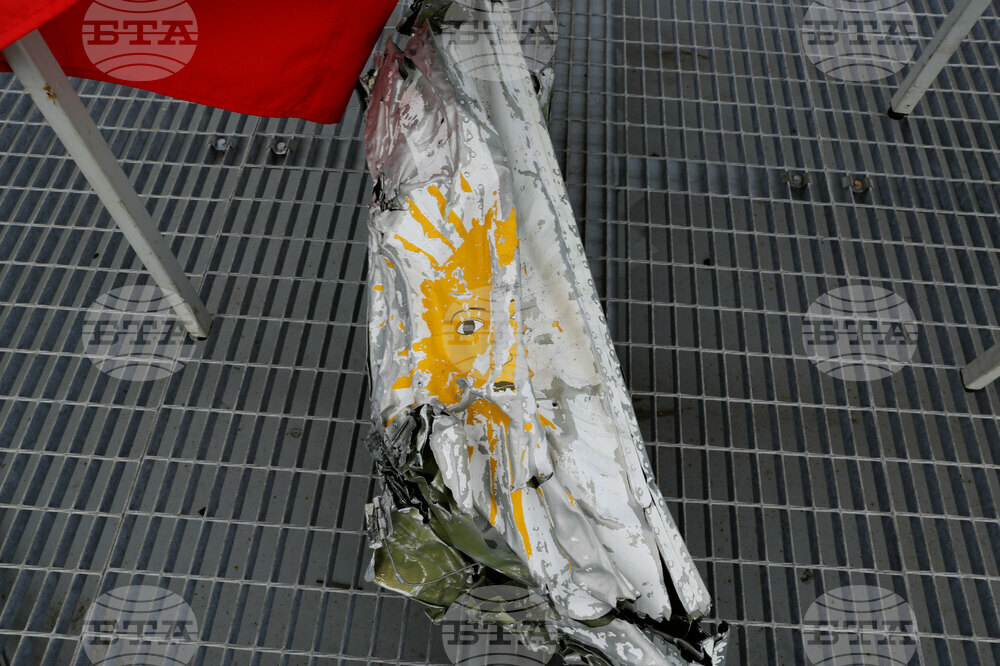
Commemorative Event Held Aboard RSV 421 Next to Fragments of Crashed Argentine Aircraft Found by Bulgarian Researchers in Antarctica
LIVINGSTON ISLAND, 05.02.2024
A commemorative ceremony was held aboard the Bulgarian naval research and survey vessel Sv. Sv. Kiril i Metodii (RSV 421) on Sunday for Argentine researchers who lost their lives in Antarctica in 1976. The researchers died in a plane crash, fragments of which were found by Bulgarian researchers at the end of January during the collection of geological samples in the area of Livingston Island's False Bay and Barnard Point. Sunday's commemorative event took place in the same area, the Nikola Vaptsarov Naval Academy reported Monday.
It was initially believed the fragments were part of a C-130 Hercules transport airplane that the Chilean Air Force lost in the area of the Drake Passage in 2019. However, Bulgarian geologists Kalin Naydenov and Kiril Doskov and climbers Doychin Boyanov and Marcho Paunov later found a part of the sun on Argentina's flag, confirming that the fragments belong to a Neptune 2-P-103 of the Argentine Naval Research Squadron.
Early on September 15, 1976, the aircraft took off from the Rio Grande Naval Base with a ten-member crew to research the state of the ice in the Drake Passage and near the South Shetland Islands. The communication with the aircraft was lost, and a crash site was later established on one of the slopes of Bernard Mountain on Livingston Island. No survivors were found. In January 1977, during a search for the crew's bodies, a BELL 212 helicopter crashed; all three crew members died.
Attending Sunday's commemorative ceremony were scientists on the expedition from the Spanish Geographical Association and Argentine polar researchers. The ceremony was unveiled by the head of the Nikola Vaptsarov Naval Academy, Flotilla Admiral Boyan Mednikarov.
BTA Photo
news.anonymous.signup
news.anonymous.login
A commemorative ceremony was held aboard the Bulgarian naval research and survey vessel Sv. Sv. Kiril i Metodii (RSV 421) on Sunday for Argentine researchers who lost their lives in Antarctica in 1976. The researchers died in a plane crash, fragments of which were found by Bulgarian researchers at the end of January during the collection of geological samples in the area of Livingston Island's False Bay and Barnard Point. Sunday's commemorative event took place in the same area, the Nikola Vaptsarov Naval Academy reported Monday.
It was initially believed the fragments were part of a C-130 Hercules transport airplane that the Chilean Air Force lost in the area of the Drake Passage in 2019. However, Bulgarian geologists Kalin Naydenov and Kiril Doskov and climbers Doychin Boyanov and Marcho Paunov later found a part of the sun on Argentina's flag, confirming that the fragments belong to a Neptune 2-P-103 of the Argentine Naval Research Squadron.
Early on September 15, 1976, the aircraft took off from the Rio Grande Naval Base with a ten-member crew to research the state of the ice in the Drake Passage and near the South Shetland Islands. The communication with the aircraft was lost, and a crash site was later established on one of the slopes of Bernard Mountain on Livingston Island. No survivors were found. In January 1977, during a search for the crew's bodies, a BELL 212 helicopter crashed; all three crew members died.
Attending Sunday's commemorative ceremony were scientists on the expedition from the Spanish Geographical Association and Argentine polar researchers. The ceremony was unveiled by the head of the Nikola Vaptsarov Naval Academy, Flotilla Admiral Boyan Mednikarov.
BTA Photo
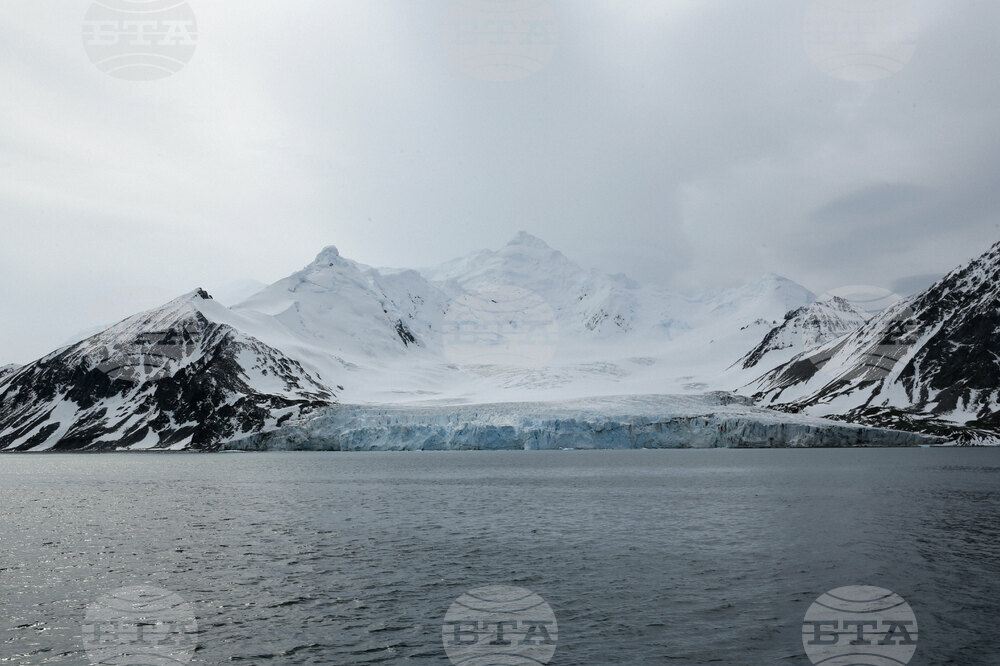
Commemorative Event Held Aboard RSV 421 Next to Fragments of Crashed Argentine Aircraft Found by Bulgarian Researchers in Antarctica
LIVINGSTON ISLAND, 05.02.2024
A commemorative ceremony was held aboard the Bulgarian naval research and survey vessel Sv. Sv. Kiril i Metodii (RSV 421) on Sunday for Argentine researchers who lost their lives in Antarctica in 1976. The researchers died in a plane crash, fragments of which were found by Bulgarian researchers at the end of January during the collection of geological samples in the area of Livingston Island's False Bay and Barnard Point. Sunday's commemorative event took place in the same area, the Nikola Vaptsarov Naval Academy reported Monday.
It was initially believed the fragments were part of a C-130 Hercules transport airplane that the Chilean Air Force lost in the area of the Drake Passage in 2019. However, Bulgarian geologists Kalin Naydenov and Kiril Doskov and climbers Doychin Boyanov and Marcho Paunov later found a part of the sun on Argentina's flag, confirming that the fragments belong to a Neptune 2-P-103 of the Argentine Naval Research Squadron.
Early on September 15, 1976, the aircraft took off from the Rio Grande Naval Base with a ten-member crew to research the state of the ice in the Drake Passage and near the South Shetland Islands. The communication with the aircraft was lost, and a crash site was later established on one of the slopes of Bernard Mountain on Livingston Island. No survivors were found. In January 1977, during a search for the crew's bodies, a BELL 212 helicopter crashed; all three crew members died.
Attending Sunday's commemorative ceremony were scientists on the expedition from the Spanish Geographical Association and Argentine polar researchers. The ceremony was unveiled by the head of the Nikola Vaptsarov Naval Academy, Flotilla Admiral Boyan Mednikarov.
BTA Photo
news.anonymous.signup
news.anonymous.login
A commemorative ceremony was held aboard the Bulgarian naval research and survey vessel Sv. Sv. Kiril i Metodii (RSV 421) on Sunday for Argentine researchers who lost their lives in Antarctica in 1976. The researchers died in a plane crash, fragments of which were found by Bulgarian researchers at the end of January during the collection of geological samples in the area of Livingston Island's False Bay and Barnard Point. Sunday's commemorative event took place in the same area, the Nikola Vaptsarov Naval Academy reported Monday.
It was initially believed the fragments were part of a C-130 Hercules transport airplane that the Chilean Air Force lost in the area of the Drake Passage in 2019. However, Bulgarian geologists Kalin Naydenov and Kiril Doskov and climbers Doychin Boyanov and Marcho Paunov later found a part of the sun on Argentina's flag, confirming that the fragments belong to a Neptune 2-P-103 of the Argentine Naval Research Squadron.
Early on September 15, 1976, the aircraft took off from the Rio Grande Naval Base with a ten-member crew to research the state of the ice in the Drake Passage and near the South Shetland Islands. The communication with the aircraft was lost, and a crash site was later established on one of the slopes of Bernard Mountain on Livingston Island. No survivors were found. In January 1977, during a search for the crew's bodies, a BELL 212 helicopter crashed; all three crew members died.
Attending Sunday's commemorative ceremony were scientists on the expedition from the Spanish Geographical Association and Argentine polar researchers. The ceremony was unveiled by the head of the Nikola Vaptsarov Naval Academy, Flotilla Admiral Boyan Mednikarov.
BTA Photo
Buy a photo
Please confirm photo buy. If you continue this purchase will be deducted from your active subscription.
Photo Download
Please confirm photo download







